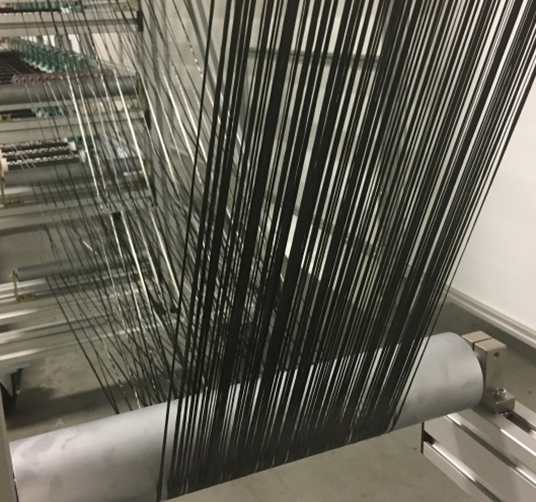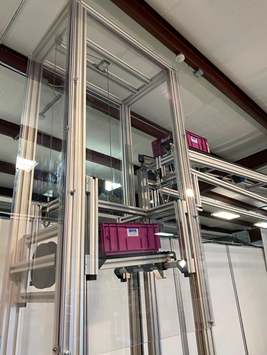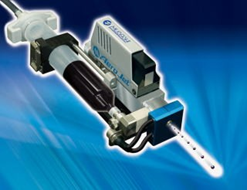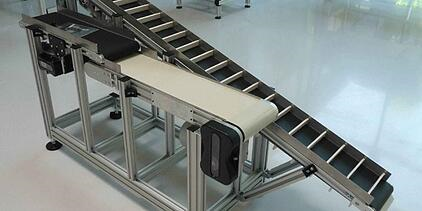The importance of the accuracy of the tension coming off of a creel or let-off is forgotten at times. Extensive design effort is put into the equipment to actually produce the sheet or tube formed from carbon fiber or other high-performance fibers, but in many cases the front end of this process is overlooked.
The accuracy of tension coming off of the creel can influence the mechanical properties of the part, and either enhance or degrade it depending on the tension control. In some cases, it is not the absolute value of tension which is important, but the minimization of deviation of tension between ends. A single tow of fiber with higher tension than the others could degrade a UD sheet or a pultruded part…. etc.
We have many success stories from our customers implementing our creels. Uniformity and improved characteristics of a UD sheet or tape, better mechanical properties observed in a pultruded part, stronger filament wound products, and better strength in a woven fabric.
Read More
Topics:
Carbon Fiber,
Speed and Length Calibration,
Robotunits,
Tension Control,
Winders
With several decades of experience building industrial control panels for our equipment delivered worldwide, Izumi International now provides industrial control panel design and fabrication services for our customers as well.
We have an in-house UL-508A certified panel shop, and have electrical engineers and electrical technicians on site to design to and build to code requirements.
Read More
Topics:
Trade Shows and News,
Carbon Fiber,
Industrial Automation,
Speed and Length Calibration,
Robotunits,
Winders
This month’s blog post focuses on our Powered Roller Conveyors. These plug-and-play conveyors transport containers, totes, and boxes with precision and efficiency in straight, curved and 90-degree directions and are ideal for zero-pressure accumulation. You can also control each zone separately.
There are several options to choose from:
- Powered Roller Conveyors. Available in straight and curved models, these units integrate a 24-volt drive and galvanized steel rollers.
Read More
Topics:
Industrial Automation,
Aluminum Extrusion,
Robotunits,
Conveyors
Let's explore the details and benefits of the Timing Belt Conveyors. Thanks to their V-guided timing belt design, these units can precisely position and transport your products. They also offer a variety of belt surface covers and attachments, making them a versatile choice for indexing, positioning and other conveying applications.
About Our Timing Belt Series
Our timing belt conveyors feature a V-guided timing belt to better handle lateral forces and are available as single lane or multiple lane systems. They also maintain consistent belt tension due to their unique belt tensioner. With this design, these reliable, adjustable conveying units can achieve perfect belt tracking and handle products of various shapes and sizes – up to 400 kilograms of load.
Read More
Topics:
Robotunits,
Conveyors
Let's explore the details and benefits of the Belt Conveyors. This system comes with your choice of belt types, drive options, position, speed and more. Each conveyor also can include a stand, flexible side guides and other accessories as needed. You can also integrate these conveyors into our Modular Automation System, saving you cost and valuable design and assembly time. Let’s take a look at some of the other features of our Belt Conveyors, including the ways this customizable series can benefit your conveying application.
A Just-in-Time Conveyor System
If you need to get a conveying system up and running quickly, then our Belt Conveyors will get the job done. This series comes with a wide selection of dimensions, belt features, belt speed and drive options, making it easy to configure a system according to your unique application requirements. Choose from frame heights of 40, 50 and 80 millimeters, as well as frame widths of 40 to 1,200 millimeters. Depending on the model you select, our Belt Conveyors can also handle loads up to 800 kilograms, with additional lengths, widths and payload capacity available upon request.
Read More
Topics:
Aluminum Extrusion,
Robotunits,
Conveyors
Karakuri ningyo (からくり人形) are traditional Japanese automated puppets with origins dating back to the 7th century. Eventually, they gained widespread popularity around 17th century Edo period in Japan, when a theater opened in Osaka with Karakuri puppets on stage. These dolls relied solely on mechanical components such as springs or cams and clever engineering techniques to produce life-like movements, such as a tea serving doll or an archer doll which loads an arrow in his bow and shoots them one by one. Fast forward to present day 2020, and we live in an age where programmable logic controllers enable precise control sequences in millisecond increments, and 6-axis robots configure a completely automated production line. We now integrate sophisticated electronic controls to fulfill our industrial automation requirements.
However, there are still industrial automation processes that can be done by a fully mechanical, “Karakuri” type system. These systems would require no electricity, which could help achieve a green manufacturing target that may be required in a plant. Having no electronic controls also means lower cost, making integration of this type of automation affordable in situations where cost is a key
Read More
Topics:
Industrial Automation,
Aluminum Extrusion,
Robotunits,
Conveyors
The Powered Roller Conveyor System from Robotunits is a multi-faceted system that handles product transportation suited to your individual needs. It is designed for immediate use with any orientation or application, and can be combined with all products of the Robotunits Modular Automation System.
Special highlight: The integrated guarding block for Poly-V belts is an integrated part of the roller design and can be assembled without tools.
| Facts |
Benefits |
| Fully integrated control units |
Plug & Play installation |
| Fully compatible in the Modular Automation System |
Accessible T-slots for attachments |
| Power transmission with Poly-V belts |
No additional guarding needed |
Watch Video Here
Read More
Topics:
Industrial Automation,
Aluminum Extrusion,
Robotunits,
Conveyors
A relatively new development in the world of fluid dispensers, the non-contact jet dispenser uses a jetting mechanism to drop fluids from a distance on to the substrate, so that the nozzle never touches the surface of the product. Jet dispensing is performed by high speed dot pulsations from the nozzle, therefore dot dispensing as well as connecting these dots to form line dispensing can be achieved.
These jetting solutions are developed by Musashi Engineering. Though relatively new in the U.S. market, Musashi Engineering is a global leader in fluid dispensing systems for industrial automation, and their product developers have fine-tuned their dispensers to provide the highest accuracy and lowest product rejection rates possible.
See some applications of the jet dispenser in this video.
The guide below goes over some of the unique benefits the jetting systems can bring to the table, and also the various jet dispenser models available.
Read More
Topics:
Robotunits,
Musashi,
Jet Dispenser
The main focus of the Robotunits technology is to offer quicker, more flexible, and more intelligent solutions. This is true in particular for the Robotunits Conveyors. The range includes high performance conveyors with a wide range of belt properties with or without cleats in different shapes and sizes. Accumulating, vacuum or magnetic conveyors and custom conveyors outside of the standard dimensions are also available by special order. The Belt Conveyor System is seamlessly integrated into the Modular Automation System: The extrusions and fasteners used in the conveyors systems are the same as the framework, making integration into equipment framework easy.
Izumi International can also integrate these conveyors into turn-key material handling solutions: for small scale systems which only require a single conveyor to large scale material handling projects requiring several conveyors.
There are a variety of conveyors in the lineup as shown below:
Read More
Topics:
Robotunits,
Conveyors
With the increasing variety of resin systems available for carbon fiber and other high-performance fibers, there is a growing need for development of sizing materials which interface well with each resin/fiber combination.
For the development of the sizing material, it is often difficult to experiment without obtaining un-sized fiber. Unless you produce the fiber in your own facility, in many cases it would be necessary to de-size the fiber first, and then apply the desired sizing materials.
Any handling process can damage the fibers, and de-sizing / re-sizing can be particularly abrasive to the fiber. Thus, equipment for this process needs to put this factor into consideration, and must be as gentle or even more gentle to the fiber as the in-line sizing process during the production of the fiber.
We can provide turn-key systems for single tow sizing development lines as well as multi-tow sizing lines for production scale output requirements. Single tow lines are scalable and configurable: in many cases they are compact table-top units. Production scale lines incorporate industrial-grade equipment, same as the equipment we provide for fiber production plants.
See below for some considerations for specifying the right equipment for the sizing line you may need.
Read More
Topics:
Carbon Fiber,
Industrial Automation,
Speed and Length Calibration,
Robotunits,
Tension Control











